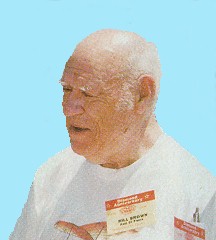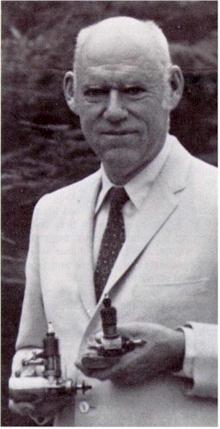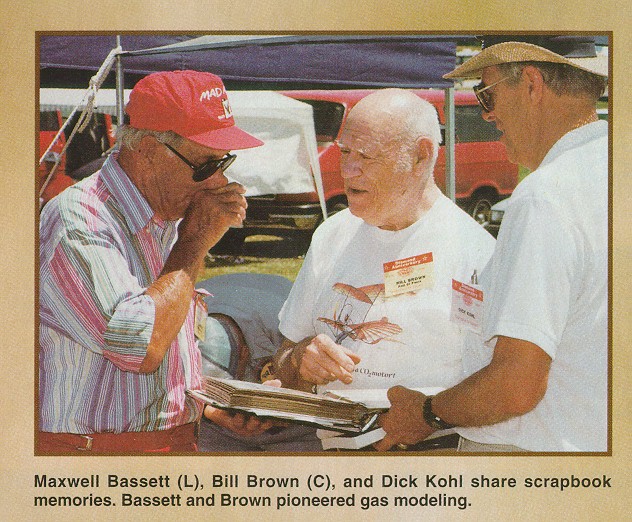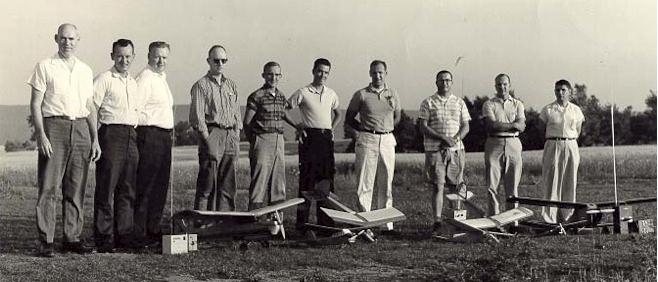

William (Bill) L. Brown IV
May 30, 1911 -- January 8, 2003
AMA Model Aviation Hall of Fame 1974
Background
1929 - First Brown gas powered model engine
1932 - Nats - First gas powered flight in competition
1934 - First production gas powered model engine, Brown Jr. Motors
1946 - Brown licensed Herkimer CO2 powered engine
1947 - Campus Industries - Bill's own A-100 CO2 powered engine
1950 - Campus Industries .29 Glo Engine
Present - Brown Junior Motors - single and twin cylinder CO2 engines
The State College Radio Control Club is privileged to have had Bill Brown as an SCRC Life Member. In addition to all his contributions to the field of model aviation in the past, Bill is continually striving to improve the involvement of today's youth in the model aviation hobby. This involvement is demonstrated each year with his contribution of a CO2 engine to the winner of the longest flight of the day at SCRC's Annual Delta Dart contest.
Bill Brown Photos

Bill Brown holds one of his first handmade engines, right, from 1930, and one of the Brown Juniors from the first production run. Photo from Model Aviation AMA News, February, 1975.

This Photograph of Bill was taken from an article, A celebration of Eagles, in the November 1996 issue of Model Aviation. It is reproduced here with the permission of the AMA.

Bill Brown is on the far left in this photograph. This photograph of some Science Park Aero Radio Club, SPARC, members and spectators was taken in the early 1960s (1960-1961). SPARC was the radio control club that was originated by several engineers at HRB Singer in the late 1950s. SPARC later became SCRC when the membership expanded to include many non HRB R/C enthusiasts.
Some Excerpts from Articles about Bill Brown
From an article in the "Philadelphia Evening Bulletin", May 30, 1931.
Built his first model airplane engines as a Senior in High School in Philadelphia, Pa.
Using one of Bill Brown's first engines mounted on an airplane built by Maxwell Bassett, the world's record for endurance (set with rubber-powered models) was broken.
These first engines were built by Bill in his home in Philadelphia.
From various issues of "The Engine Collector Journal".
1934
First record of production of model engines from "Brown Junior Motors Company" of Philadelphia. This engine had no name on the crankcase.
1937 through 1940
Production of various Brown Jr. engines from Model "B" in 1937 to "Brownie" in 1940. It appears that Bill Brown was associated with Brown Jr. Motor Co. from 1934 through 1940. There does not appear to be any model engine activity during the Second World War years.
However, during the war years, Bill invented and patented the CO2 engine.
1946
Bill licensed Herkimer Tool & Model Works (OK Engines) to produce the CO2 engine as the OK CO2 engine.
1947
Bill formed Campus Industries, produced and sold the A-100 (0.0015 m3) and the "Bee" (larger version of the A-100).
1950
Designed and produced the Campus 0.29 Glo engine. This was the last internal combustion engine he built. It would appear that he ran Campus Industries from 1947 through 1950 or 1951.
There is no record of model engine manufacturing activity recorded from 1951 until his formation of the "new" Brown Junior Motors about 1970 0r 1971 to produce a run of 1000 Brown Jr. CO2 engines.
A link to a Historical Overview of Bill Brown Motors
Excerpts from the CDT Obituary for Bill Brown
William Likens Brown IV, 91, of Pine Grove Mills, died Wednesday, Jan. 8, 2003, at The Fairways at Brookline Village.
He was a resident of Salem Hill Haven in Spring Mills from April 2002 to Jan. 1. He was a resident of Ferguson Township since 1950 and, before that, lived in Philadelphia.
Born May 30, 1911, in Elkins Park, Montgomery County, he was a son of the late William Likens Brown III and Grace Emma Herbert Brown.
On Sept. 14, 1940, he married Dorothy Margaret Craven, who survives.
He was a 1932 graduate of Frankford High School in Philadelphia. He studied mechanical engineering at the Pennsylvania State College for the next two years.
A pioneer in model-aircraft aviation, he built the first practical gasoline-powered model aircraft engine in 1930, while he was attending high school. One of his early engines powered The Miss Philadelphia III, a model plane designed by his close friend, Maxwell Bassett, at the 1933 National Championship Model Plane Meet, held at Roosevelt Field on Long Island. The small plane remained aloft for a record 28 minutes. The model aircraft powered by the Brown gasoline engine went on to sweep every major category in the competition, revolutionizing a sport in which models had been powered by rubber bands.
The Junior Motors Corp. of Philadelphia, co-founded by his father, manufactured the gasoline engines from 1934 to 1940. He later created Campus Industries to achieve his dream of developing a carbon-dioxide engine. In 1942-43, he designed and built the first successful carbon-dioxide-powered engine for small model aircraft. In 1950, Campus Industries (later Micro-Tol) relocated to Pine Grove Mills. The current Brown Junior Motors Inc. was established in 1968 to manufacture carbon-dioxide engines. Throughout the next several decades, he refined the engines. In 1994, he created the world's smallest single-cylinder reciprocating carbon-dioxide engine.
He received numerous awards and accolades for his work. Several of his early engines are included in the collections of the Smithsonian National Air and Space Museum in Washington and the Deutsches Museum in Munich, Germany. In 1974, he was elected to the Academy of Model Aeronautics Model Aviation Hall of Fame, and to the Free Flight Hall of Fame of the National Free Flight Society in 1979. He was recognized internationally for his achievements and, in 1991, was invited to celebrate his 80th birthday at an International Model Meet in Spitzerberg, Austria.
He was passionate about the field of model aviation and encouraged young people to develop an interest in it. He enjoyed demonstrating his engines at the Centre Region Parks and Recreation's annual Delta Dart competition and always donated one of his engines as the grand prize. He was a visionary who hoped someday to build a park for model enthusiasts and an aerodome in which to fly model planes.
A master machinist, he was employed during his early years at Leeds and Northrup and the Franklin Institute in Philadelphia and the Ordnance Research Laboratory (now the Applied Research Laboratory).
He built the wind tunnel balance for the mechanical engineering department at Penn State.
He was a member of the University Baptist and Brethren Church in State College, serving as a deacon. He was also an active member of the Gideons International and a life member of the Society of Antique Modelers. He was a flutist in the Penn State Symphony Orchestra and was also an amateur stone mason. He loved riding his Indian motorcycle in his early years and piloting both glider and power planes in his later years.
Return to SCRC Home Page
Last Updated 1/11/2003